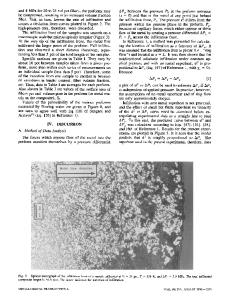Infiltration of fibrous preforms by a pure metal: Part I. Theory
- PDF / 1,608,733 Bytes
- 13 Pages / 612 x 792 pts (letter) Page_size
- 1 Downloads / 387 Views
I.
INTRODUCTION
T H E liquid metal infiltration process for fabricating fiberreinforced metals consists of the injection and subsequent solidification of liquid metal within the interstitial spaces of a fiber preform. Fluid flow aspects of the infiltration process can be treated readily following the extensive literature on flow of fluids through porous media, an important topic in soil science and chemical engineering. The problem of interest here has additional heat flow and solidification aspects, since the fibers are often held at a temperature significantly below the melting point of the matrix to minimize chemical reactions. In an adiabatic infiltration problem, heat will be exchanged between the metal and the fibers. In a nonadiabatic problem, heat flow will additionally take place between the composite and its surroundings, as is usually the case in casting processes. These heat transfer phenomena are of importance, because they influence both infiltration kinetics and the resulting metal microstructure in the composite. Because of its considerable engineering relevance to metal matrix composite fabrication, the infiltration process has already been studied by several authors, from both theoretical and experimental standpoints. Nagata and Matsuda(J.2} have investigated the infiltration of particles ranging in size from 37 to 3400/~m. They propose the
A. MORTENSEN, Assistant Professor, J.A. CORNIE, Principal Research Associate, and M.C. FLEMINGS, Professor and Department Head, are with the Department of Materials Science and Engineering, Massachusetts Institute of Technology, Cambridge, MA 02139. L.J. MASUR, formerly a Graduate Student with the Department of Materials Science and Engineering, Massachusetts Institute of Technology, is Senior Scientist with the American Superconductor Corporation, Cambridge, MA 02139. Manuscript submitted June 7, 1988. METALLURGICAL TRANSACTIONS A
existence of a critical preheat temperature based upon physical constants of the metal and particles, above which the particles must be heated in order for infiltration to occur. Their calculations are based upon an overall thermal balance between the particles and the metal. Hosking and Netz t3~ have studied the infiltration of an aluminum alloy into a packed bed of particles ranging in size from 3 to 9 mm. They present a statistically derived expression that is based upon their experimental results. On the flow of liquid metals through assemblies of fibers, Fukunaga has made experimental measurements and theoretical calculations of the permeability of a fibrous preform, which are summarized in a recent publication, t4] Fukunaga and Goda propose the formation of a layer of solidified metal on the fibers and verify its existence through the use of mechanical tests on leachedout fibers. (5] They then derive a Kozeny-type expression for the infiltration coefficient which agrees with experimental measurements. [6] Fukunaga and Goda also propose a critical infiltration velocity as the mechanism for cessation of flow. Girot e t al. t7
Data Loading...










